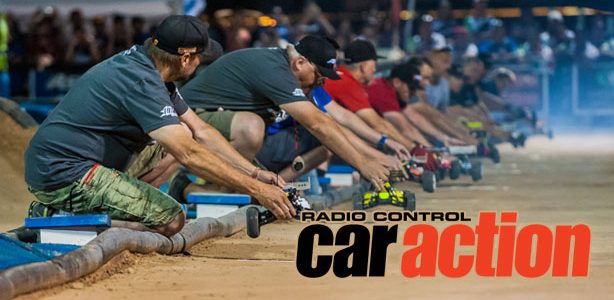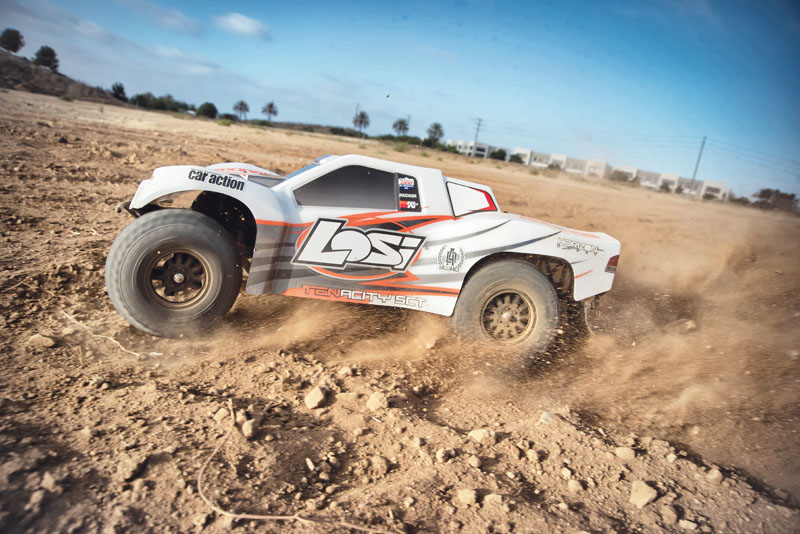Latest from ROAR:
Former RC Car Action Executive Editor Steve Pond has been elected ROAR President. For racers, that’s big news because ROAR plays an integral part in our industry. ROAR, which stands for Remotely Operated Auto Racers, is the sanctioning organization for RC racers in North America. There are 14 regions within ROAR. ROAR is responsible for creating/upholding rules, choosing which National events to host and their appropriate venues, and for ultimately improving the sport of RC racing. Rules that ROAR enforces often dictate which direction manufacturers go with the design of vehicles, bodies, electronics and wheels and tires. Pond has been an employee of Kyosho America the past several years and is an avid RC enthusiast.
Below is RC Car Action’s exclusive interview with Steve to discuss his plans, ROAR’s future, and much, much more.
RCCA: What should RC racers know about Steve Pond?
Well, I’ll try to give you the short version. I got my first glimpse of an RC car at the New York Auto Show sometime around 1974. I went to the show with my father, and off to the side on one of the upper floors were these incredibly fast RC cars that were doing things that I never imagined possible – faster and more nimble than I’d ever seen. I was completely fascinated by their performance, and it was the beginning of what has been a life-long career.
Around 1976 I picked up my first RC car, which would be considered toy-grade. Then of course I saved up for a nitro-powered machine that was way over my head, at which point I had already made the first of thousands of mistakes that spans 35 years. Back then, RC cars weren’t nearly as refined as they are today. So, being an RC enthusiast in the early days required much more knowledge (something I was sorely lacking), at least when dealing with a high-performance racing machine.
Some 8 years later, I met this guy who had just graduated from Marquette University in a chance encounter through a mutual friend. He and his sister were taking back control of their family’s publishing company. It wasn’t long afterward that I was working at Air Age Publishing (now Air Age Media) with Louis and Yvonne DeFrancesco. I started running blueprints (and inhaling a LOT of ammonia fumes) used by model airplane enthusiasts to make RC planes from scratch. I eventually worked my way through many positions within the company, which led to becoming Executive Editor. I helped launch Car Action Magazine in 1985, which developed into the largest RC car magazine in the World. I also conceptualized and launched RC Nitro Magazine as its Executive Editor in the late 90s, which was dedicated to nitro enthusiasts when nitro started to really explode into the market. It was a great experience that helped to create later opportunities working Tekin Electronics when it was still owned by its founder, Kevin Ortin, and most recently with Kyosho.
My hobby and career in the RC business has provided me with a unique opportunity to view the market from the perspective of a consumer, racer, media representative, and from the vantage point of various manufacturers. This wide range of experience, combined with life-long enthusiasm and enjoyment of the RC hobby and racing segments, is something that I hope to apply during my tenure with ROAR. As someone who’s got so much from RC, I feel that it’s necessary to give something back to the organization that’s given us the framework for fair and equal competition for decades.
RCCA: What are some of your short term and long term goals with ROAR?
SP: ROAR has done very well under the direction of Dawn Sanchez for quite a few years. Her unrelenting enthusiasm, sharp organizational skills and ability to marshal the troops is Zen-like and quite admirable. She’s left some big shoes to fill, so my first goal is to at least match what Dawn has given in the service of this hobby, and to be sure to maintain the sense of organization and efficiency that she’s put in place. Her contribution can’t be overstated – her contributions are quite significant and need to remain a prominent part of the organization’s framework.
As it relates to the actual business of ROAR, I want to modernize the processes and procedures to make it more compatible with the instant media. We’re making a slight modifications to the rules for Nationals that will allow media and their readers/website visitors to have more information about what’s happening at all stages of the event.
I also want to emphasize the importance of making ROAR as inclusive as possible. As racers, we tend to forget what it’s like to be a novice who wants to get involved in racing. The complexity, cost and barriers to entry have risen to an unrealistic level, and it needs to be more moderate and inviting. I also understand the vital importance of keeping the scale appearance of classes that rise to popularity on the strength of scale appearance. We always want to push the limits and get everything lower and faster, but it’s detrimental to lose one of the foremost aspects of what made these categories so popular early on.
My long-term goal is to have more active participation with manufacturers and retailers. If we can create an environment in which ROAR, racers, hobby shops, track operators and manufacturers can work in a coordinated manner and everyone feels as though they’re part of the process, then the final result will always be better than if we’re all just drifting in the same direction by coincidence.
RCCA: How much of a role does RC racing play in the broader scope of RC as a whole?
SP: Like full-scale auto racing, RC racing plays a big role in the development of products intended for the broader market. A lot of the technology that’s developed for racing eventually trickles down to vehicles that aren’t usually considered for racing. ESCs, batteries, chargers, radios, servos, and the cars themselves have all benefitted from the more intense development that takes place at the race track. What we can’t lose sight of, is the fact that the racing market is also dependent on the non-racing market. The volume of sales to non-racing enthusiasts ranges from 10-50 to 1, which means hobby dealers will sell upward of 50 non-racing vehicles for every one racing vehicle. The much higher volume of non-racing sales provides economies of scale that absolutely wouldn’t be possible from racing sales alone. In other words, without the benefit of sales in the non-racing market, the racing would not exist. So the two aspects are interdependent and would have a much harder time surviving without the other.
RCCA: Do you or ROAR have any immediate changes planned that racers, tracks and manufacturers should be aware of?
SP: Two of the most significant changes we’ve discussed are motors for the 4×4 short course category, and motors and ESCs for the stock electric classes. ROAR’s original decision to use 540 motors in the 4×4 SC class was based on two reasons. ROAR only had specs for two classes of brushless motors; the 05/540 size motors, and the big 4-pole 1/8 motors. The 540 is the obvious choice among the two because it keeps speed and power in a range that’s appropriate for the entry level and novice driver that should be driving these vehicles, and the big 1/8 motors are far too powerful and too big to fit in most cases. 550-size brushless motors have become a little more popular in the 4×4 class, and although it provides too much power for the average racer, ROAR has decided to make 550-size two-pole, 3-slot motors in the 4×4 short course class.
The second change is that ROAR will be consulting with manufacturers to create ESCs and motors that are more appropriate for stock class racing. The stock class has always been the entry point for novice and intermediate racers, and the advent of higher performance motors and programmable speed controllers with dynamic timing have pushed the speeds well beyond what is reason for the intended purpose of the class. So, there’s currently an interim solution for new software that removes the timing from the ESC for the stock classes. For the 2012 season we will be working with ESC and motor manufactures to create a specification for a non-programmable, zero-timing ESC (many of these exist already) and motors with non-adjustable timing to simulate what ROAR once had with the fixed timing brushless motors. The necessity of reducing cost and complexity drives this, but it’s also going to promote closer, more competitive racing at a significantly reduced cost.
RCCA: What’s one of the biggest misconceptions about ROAR?
SP: Like the magazines, ROAR is often mistaken to be able to create markets with its rules. The fact is, ROAR typically responds to vehicles and products that the membership decides is “cool” enough. So ROAR doesn’t make the classes, it just creates rules for categories that the RC community determines are popular. ROAR doesn’t create classes – racers do.
I guess the “biggest” depends on your perspective. The objectives of a sanctioning body and that of a racer are typically in direct conflict with one another. ROAR’s objective is to create rules for a fair, economical and fun racing environment. Racers on the other hand, are doing everything they can to ensure an unfair racing environment. That’s not to say that they’re cheating, but it’s the nature of racing that you’re always looking for whatever advantage you can get to win. So, the opposing nature of those two objectives can stir some emotions and can lead to accusations that ROAR “doesn’t know what they’re doing.” I can tell you that ROAR has some of the most experienced and intelligent volunteers available, who spend a lot of their free time formulating rules that will encourage fair competition. It’s a volunteer organization that has the best interests of the whole racing community at its core.
Trevor “Chilly” Duncan
Online News Editor
Radio Control Car Action
rccanews@airage.com
https://www.rccaraction.com








![RC Car Action - RC Cars & Trucks | This 1/3 scale 125cc V10 Buggy is CRAZY [VIDEO]](https://www.rccaraction.com/wp-content/uploads/2018/05/V10-HP.jpg)


 Stay up to date with the latest information, sign up for our FREE newsletter today.
Stay up to date with the latest information, sign up for our FREE newsletter today.
